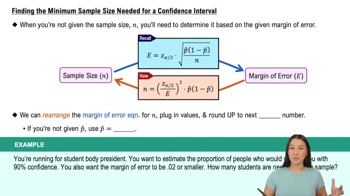Table of contents
- 1. Intro to Stats and Collecting Data55m
- 2. Describing Data with Tables and Graphs1h 55m
- 3. Describing Data Numerically1h 45m
- 4. Probability2h 16m
- 5. Binomial Distribution & Discrete Random Variables2h 33m
- 6. Normal Distribution and Continuous Random Variables1h 38m
- 7. Sampling Distributions & Confidence Intervals: Mean1h 3m
- 8. Sampling Distributions & Confidence Intervals: Proportion1h 12m
- 9. Hypothesis Testing for One Sample1h 1m
- 10. Hypothesis Testing for Two Samples2h 8m
- 11. Correlation48m
- 12. Regression1h 4m
- 13. Chi-Square Tests & Goodness of Fit1h 20m
- 14. ANOVA1h 0m
8. Sampling Distributions & Confidence Intervals: Proportion
Confidence Intervals for Population Proportion
Struggling with Statistics?
Join thousands of students who trust us to help them ace their exams!Watch the first videoMultiple Choice
You wish to estimate with confidence the population proportion of people in Gen-Z that use social media. If you want your estimate to be accurate within of the population proportion, what is the minimum sample size needed?
A
422
B
423
C
405
D
406
 Verified step by step guidance
Verified step by step guidance1
Identify the confidence level and margin of error: The confidence level is 90%, and the margin of error is 4% (0.04).
Determine the critical value (z-score) for a 90% confidence level. This can be found using a standard normal distribution table or calculator. The z-score for 90% confidence is approximately 1.645.
Use the formula for sample size estimation for a proportion: n = (z^2 * p * (1-p)) / E^2, where n is the sample size, z is the z-score, p is the estimated population proportion, and E is the margin of error.
Assume the most conservative estimate for the population proportion, p = 0.5, to ensure the maximum sample size. This is because the product p*(1-p) is maximized when p = 0.5.
Substitute the values into the formula: n = (1.645^2 * 0.5 * 0.5) / 0.04^2. Calculate the result to find the minimum sample size needed.

 5:45m
5:45mWatch next
Master Constructing Confidence Intervals for Proportions with a bite sized video explanation from Patrick
Start learningRelated Videos
Related Practice






